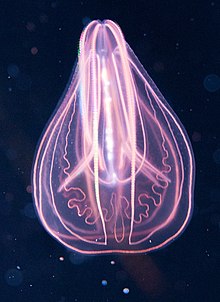| Comb jellies | |
|---|---|

| |
| Scientific classification | |
| Domain: | Eukaryota |
| Kingdom: | Animalia |
| Phylum: | Ctenophora Eschscholtz, 1829 |
| Classes | |
Ctenophora (/təˈnɒfərə/ tə-NOF-ər-ə; sg.: ctenophore /ˈtɛnəfɔːr, ˈtiːnə-/ TEN-ə-for, TEE-nə-; from Ancient Greek κτείς (kteis) 'comb' and φέρω (pherō) 'to carry')[6] comprise a phylum of marine invertebrates, commonly known as comb jellies, that inhabit sea waters worldwide. They are notable for the groups of cilia they use for swimming (commonly referred to as "combs"), and they are the largest animals to swim with the help of cilia.
Depending on the species, adult ctenophores range from a few millimeters to 1.5 m (5 ft) in size. Only 186 living species are currently recognised.[7]
Their bodies consist of a mass of jelly, with a layer two cells thick on the outside, and another lining the internal cavity. The phylum has a wide range of body forms, including the egg-shaped cydippids with a pair of retractable tentacles that capture prey, the flat, generally combless platyctenids, and the large-mouthed beroids, which prey on other ctenophores.
Almost all ctenophores function as predators, taking prey ranging from microscopic larvae and rotifers to the adults of small crustaceans; the exceptions are juveniles of two species, which live as parasites on the salps on which adults of their species feed.
Despite their soft, gelatinous bodies, fossils thought to represent ctenophores appear in Lagerstätten dating as far back as the early Cambrian, about 525 million years ago. The position of the ctenophores in the "tree of life" has long been debated in molecular phylogenetics studies. Biologists proposed that ctenophores constitute the second-earliest branching animal lineage, with sponges being the sister-group to all other multicellular animals (Porifera sister hypothesis).[8] Other biologists contend that ctenophores emerged earlier than sponges (Ctenophora sister hypothesis), which themselves appeared before the split between cnidarians and bilaterians.[9][10] Pisani et al. reanalyzed the data and suggested that the computer algorithms used for analysis were misled by the presence of specific ctenophore genes that were markedly different from those of other species.[11][12][page needed] Follow up analysis by Whelan et al. (2017)[13] yielded further support for the 'Ctenophora sister' hypothesis; the issue remains a matter of taxonomic dispute.[14][15] Schultz et al. (2023) found irreversible changes in synteny in the sister of the Ctenophora, the Myriazoa, consisting of the rest of the animals.[16]
- ^ Chen, Jun-Yuan; Schopf, J. William; Bottjer, David J.; Zhang, Chen-Yu; Kudryavtsev, Anatoliy B.; Tripathi, Abhishek B.; et al. (April 2007). "Raman spectra of a Lower Cambrian ctenophore embryo from southwestern Shaanxi, China". Proceedings of the National Academy of Sciences of the United States of America. 104 (15): 6289–6292. Bibcode:2007PNAS..104.6289C. doi:10.1073/pnas.0701246104. PMC 1847456. PMID 17404242.
- ^ Stanley, G.D.; Stürmer, W. (9 June 1983). "The first fossil ctenophore from the Lower Devonian of West Germany". Nature. 303 (5917): 518–520. Bibcode:1983Natur.303..518S. doi:10.1038/303518a0. S2CID 4259485.
- ^ Conway Morris, S.; Collins, D.H. (29 March 1996). "Middle Cambrian Ctenophores from the Stephen Formation, British Columbia, Canada". Philosophical Transactions of the Royal Society B: Biological Sciences. 351 (1337): 279–308. Bibcode:1996RSPTB.351..279C. doi:10.1098/rstb.1996.0024.
- ^ Cite error: The named reference
Tang2011was invoked but never defined (see the help page). - ^ Shu, Degan; Zhang, Zhifei; Zhang, Fang; Sun, Ge; Han, Jian; Xiao, Shuhai; Ou, Qiang (July 2015). "A vanished history of skeletonization in Cambrian comb jellies". Science Advances. 1 (6): e1500092. Bibcode:2015SciA....1E0092O. doi:10.1126/sciadv.1500092. PMC 4646772. PMID 26601209.
- ^ Fowler, George Herbert (1911). . In Chisholm, Hugh (ed.). Encyclopædia Britannica. Vol. 7 (11th ed.). Cambridge University Press. p. 593.
- ^ World Register of Marine Species (database). VLIZ. 18 September 2019. Retrieved 19 February 2024.
- ^ Simion, Paul; Philippe, Hervé; Baurain, Denis; Jager, Muriel; Richter, Daniel J.; diFranco, Arnaud; et al. (2017). "A large and consistent phylogenomic dataset supports sponges as the sister group to all other animals". Current Biology. 27 (7): 958–967. Bibcode:2017CBio...27..958S. doi:10.1016/j.cub.2017.02.031. PMID 28318975.
- ^ Dunn, Casey W.; Hejnol, Andreas; Matus, David Q.; Pang, Kevin; Browne, William E.; Smith, Stephen A.; et al. (2008). "Broad phylogenomic sampling improves resolution of the animal tree of life". Nature. 452 (7188): 745–749. Bibcode:2008Natur.452..745D. doi:10.1038/nature06614. PMID 18322464. S2CID 4397099.
- ^ Baxevanis, Andreas D.; Martindale, Mark Q.; Mullikin, James C.; Wolfsberg, Tyra G.; Dunn, Casey W.; Haddock, Steven H.D.; et al. (13 December 2013). "The genome of the Ctenophore Mnemiopsis leidyi and its implications for cell type evolution". Science. 342 (6164): 1242592. doi:10.1126/science.1242592. PMC 3920664. PMID 24337300.
- ^ Pisani, Davide; Pett, Walker; Dohrmann, Martin; Feuda, Roberto; Rota-Stabelli, Omar; Philippe, Hervé; et al. (2015). "Genomic data do not support comb jellies as the sister group to all other animals". Proceedings of the National Academy of Sciences of the U.S.A. 112 (50): 15402–15407. Bibcode:2015PNAS..11215402P. doi:10.1073/pnas.1518127112. PMC 4687580. PMID 26621703.
- ^ Berwald, Juli (November 2017). Spineless: The science of jellyfish and the art of growing a backbone. Ivanyi, Rachel (illus.) (1st hdbk ed.). New York, NY: Riverhead Books (Penguin Random House). ISBN 978-0735211261. LCCN 2017005838.
- ^ Whelan, Nathan V.; Kocot, Kevin M.; Moroz, Tatiana P.; Mukherjee, Krishanu; Williams, Peter; Paulay, Gustav; et al. (November 2017). "Ctenophore relationships and their placement as the sister group to all other animals". Nature Ecology & Evolution. 1 (11): 1737–1746. Bibcode:2017NatEE...1.1737W. doi:10.1038/s41559-017-0331-3. PMC 5664179. PMID 28993654.
- ^ Halanych, Kenneth M.; Whelan, Nathan V.; Kocot, Kevin M.; Kohn, Andrea B.; Moroz, Leonid L. (9 February 2016). "Miscues misplace sponges". Proceedings of the National Academy of Sciences of the U.S.A. 113 (8): E946–E947. Bibcode:2016PNAS..113E.946H. doi:10.1073/pnas.1525332113. ISSN 0027-8424. PMC 4776479. PMID 26862177.
- ^ Telford, Maximilian J.; Moroz, Leonid L.; Halanych, Kenneth M. (January 2016). "A sisterly dispute". Nature. 529 (7586): 286–287. doi:10.1038/529286a. ISSN 1476-4687. PMID 26791714. S2CID 4447056.
- ^ Schultz, Darrin T.; Haddock, Steven H.D.; Bredeson, Jessen V.; Green, Richard E.; Simakov, Oleg; Rokhsar, Daniel S. (17 May 2023). "Ancient gene linkages support ctenophores as sister to other animals". Nature. 618 (7963): 110–117. Bibcode:2023Natur.618..110S. doi:10.1038/s41586-023-05936-6. ISSN 1476-4687. PMC 10232365. PMID 37198475.